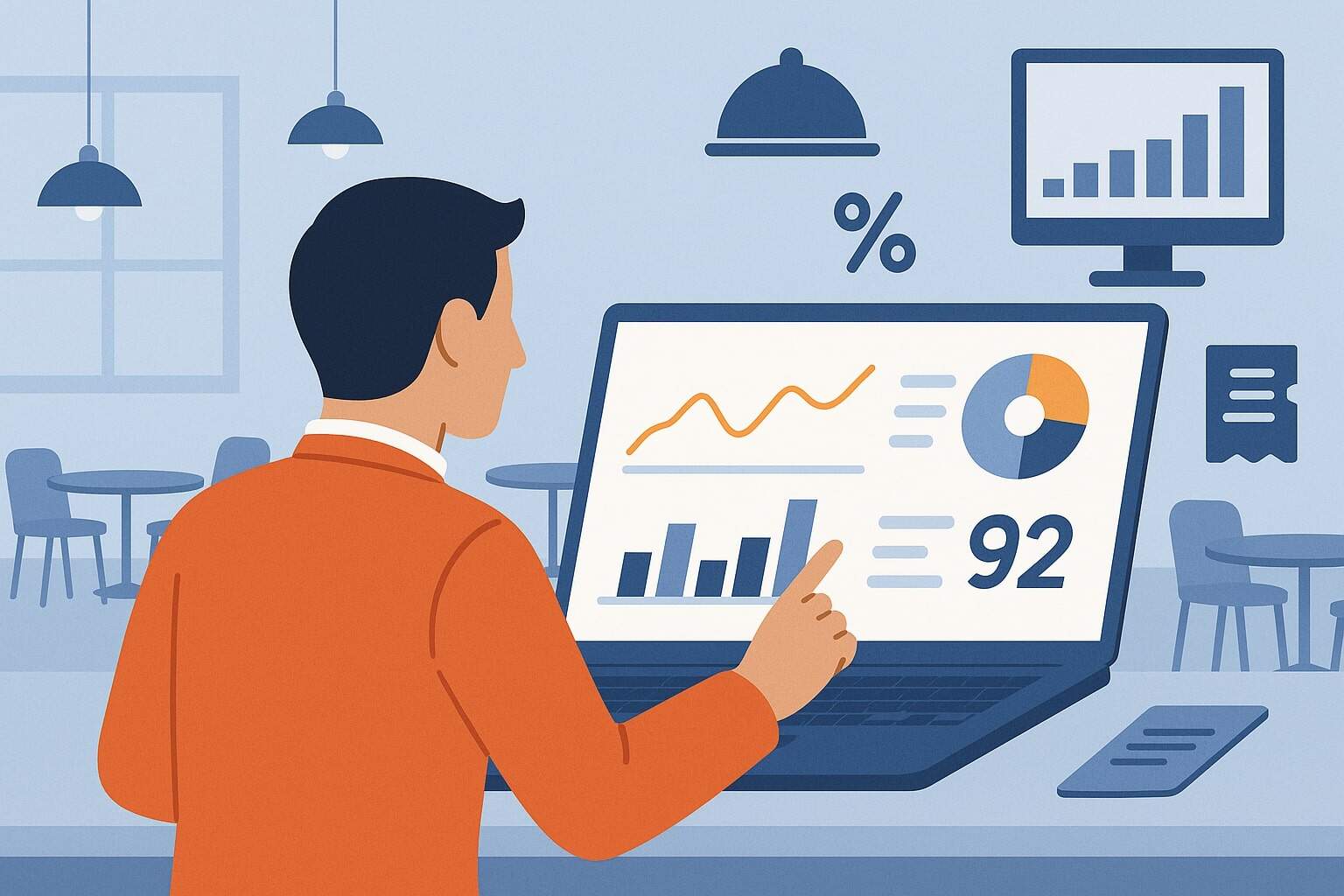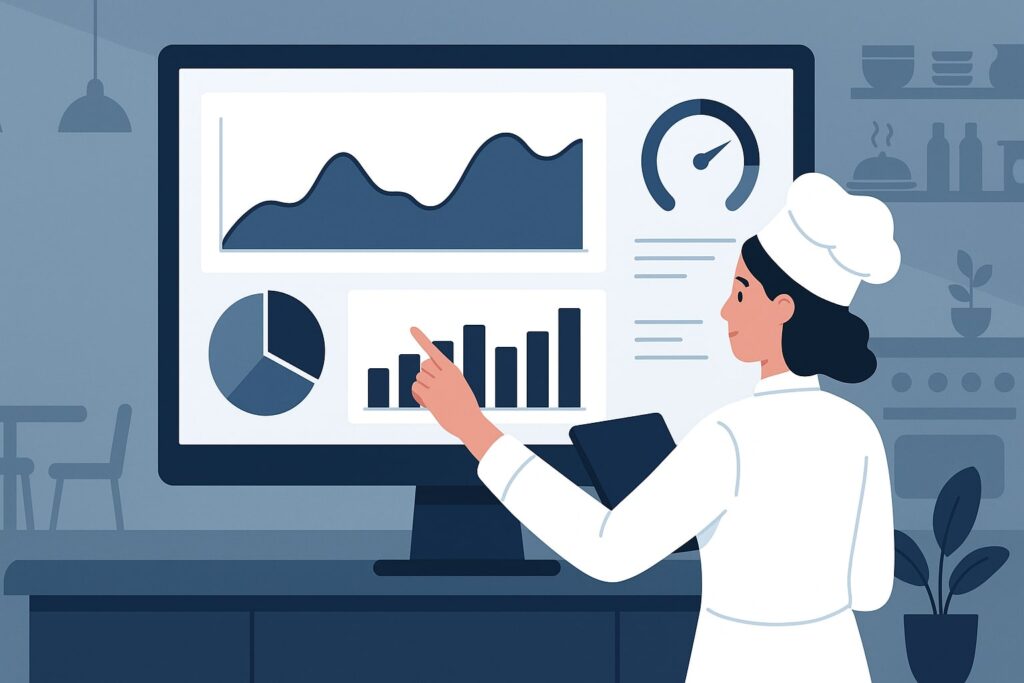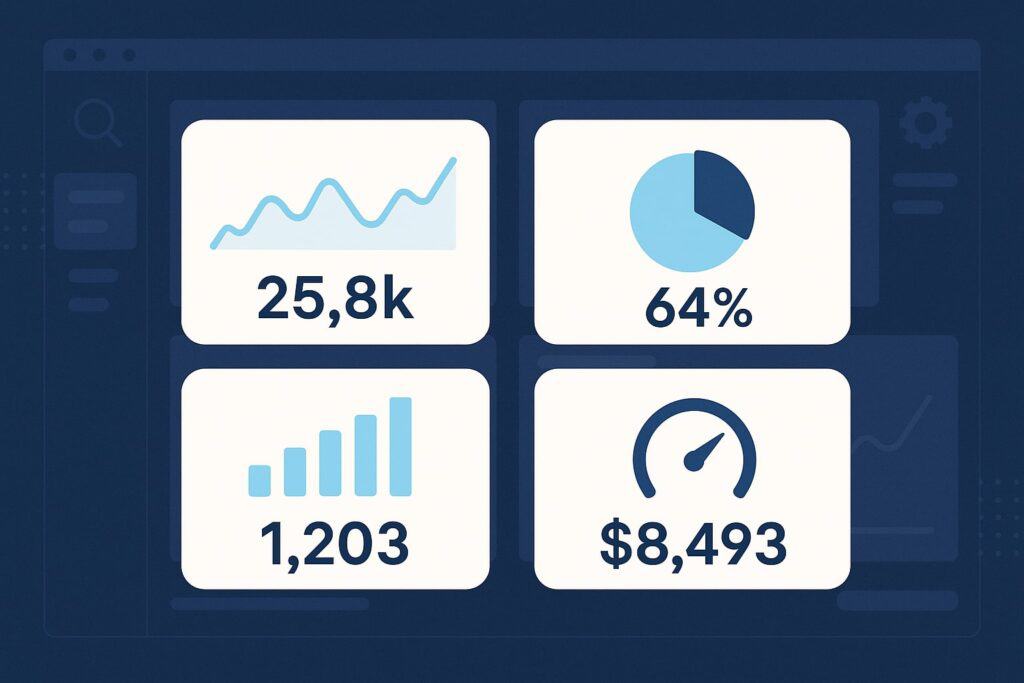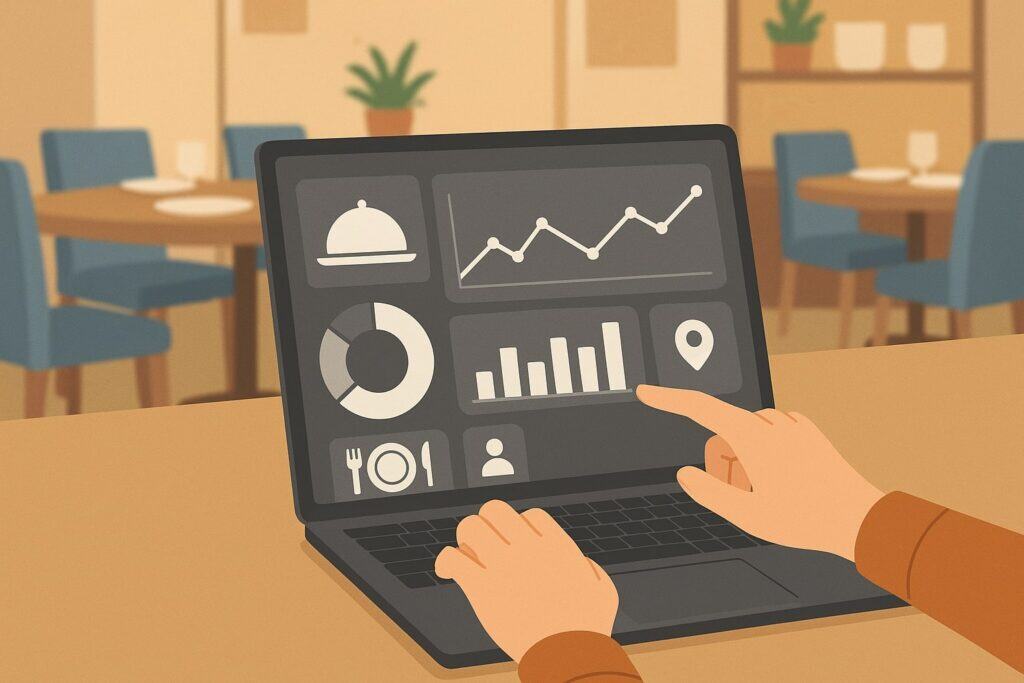
By cloudrestaurantmanager October 12, 2025
In today’s fast-paced foodservice landscape, real-time restaurant dashboards are transforming how operators monitor performance, make decisions, and optimize operations. These dashboards capture live data across key areas—sales, labor, inventory, customer activity—and display it in intuitive visual forms.
By delivering actionable insights at a glance, a real-time restaurant dashboard empowers managers, chefs, and franchise owners to react swiftly, steer strategy, and maintain high service quality.
In this article, we’ll explore what real-time restaurant dashboards show, why they matter now more than ever, key metrics to monitor, best practices for implementation, challenges, and a detailed FAQ section. The goal is to offer a clear, up-to-date guide that’s both practical and reader-friendly.
What Is a Real-Time Restaurant Dashboard?
A real-time restaurant dashboard is a centralized, visual interface that aggregates live data from multiple systems—point of sale (POS), kitchen display systems (KDS), inventory management, online ordering platforms, and labor scheduling tools—and presents this information in digestible charts, gauges, and trend lines.
Unlike static reports, the data updates continuously (or at short intervals), giving operators a pulse on current performance.
These dashboards typically offer modular widgets (sales heat maps, order volume, ticket time, labor cost percentages, inventory alerts). Because all key data streams link in real time, restaurant leaders can detect anomalies, compare performance versus targets, and make decisions instantly—rather than waiting hours or days for report generation.
Real-time restaurant dashboards are often delivered via cloud software, accessible on desktops, tablets, or smartphones. Integration with APIs and webhooks allows different systems (POS, delivery apps, inventory) to feed data automatically. Some dashboards include predictive alerts and AI-based insights that flag deviations or forecast future trends.
In sum, a real-time restaurant dashboard is far more than a pretty visualization. It is the nerve center for operations, giving restaurants one lens through which to view, understand, and act on performance metrics as they evolve.
Why Real-Time Dashboards Matter for Restaurants

Rapid Decision Making and Responsiveness
Because the restaurant industry is dynamic, delays in reacting can cost money or reputation. With real-time dashboards, staff can identify surges in orders, bottlenecks in kitchen throughput, unexpected labor overages, or inventory shortfalls the moment they occur.
This speed of insight means managers can adapt—reassign staff, hold off promotions, reorder stock, or adjust menus.
Alignment of Goals Across Teams
Dashboards provide a shared operational view. The kitchen, floor, front-of-house, and management teams can all see the same KPIs, fostering alignment. When everyone uses the dashboard, there’s less finger-pointing and more accountability. A unified view helps ensure that labor efficiency, food cost targets, and service benchmarks move in concert.
Cost Control and Profit Optimization
One of the most critical roles of a real-time gallery of metrics is to help control costs. Seeing labor percentage creep up while sales stagnate, or spotting a spike in food waste, allows swift mitigation.
Real-time dashboards also help monitor margins on specific menu items, enabling dynamic decisions (e.g. temporarily promoting high-margin dishes or removing underperformers).
Enhanced Customer Experience
Operational delays (order errors, slow service, stockouts) directly impact guests. Real-time dashboards highlight queue buildup or slow ticket times mid-service, so staff can reallocate effort (e.g., open an extra register, call for backup). This responsiveness helps maintain quality and customer satisfaction—even during peak hours.
Scalability and Growth
As restaurants scale—opening new locations, launching delivery channels, or running ghost kitchens—real-time dashboards become vital.
They allow regional managers to monitor performance across multiple sites, identify best practices, or flag struggling units. This scalability is far harder if each site relies on delayed, manual reporting.
Competitive Advantage
Restaurants that adopt real-time dashboards gain a data-driven edge. They can launch limited-time promotions mid-service based on demand, A/B test pricing on the fly, or respond faster to staffing challenges. This agility can set them apart in a dense marketplace.
Given the razor margins in foodservice, these advantages are not abstract: they translate into real savings, better resource utilization, less waste, higher throughput, and stronger guest loyalty.
Core Metrics Displayed on Real-Time Dashboards

In this section, we break down the most critical metrics that modern restaurant dashboards show, and why each matters. A well-designed dashboard selects only the most relevant metrics rather than overwhelming users with everything.
Sales Metrics
- Total Sales / Revenue – The real-time total of what’s being generated now vs target. This is often shown by hour or by day-to-date.
- Sales by Hour / Time of Day – A heat map or bar chart showing hourly trends, enabling managers to see peak windows and plan staffing or promotions.
- Sales by Channel – Online orders, in-house dining, delivery, take-out, third-party apps. Comparing channels helps assess performance and profitability of each.
- Average Order Value (AOV) – Real-time AOV gives insight into where customers are spending more or less, and which combinations sell best.
- Item-Level Sales / Product Mix – A ranking of top-selling and underperforming menu items. Helps decide which items to push and which to consider removing.
These sales metrics feed the rest of the dashboard logic—labor, inventory, margin estimation, and so on.
Labor & Staffing Metrics
- Labor Cost Percentage – Ratio of labor expense to sales in real time. If it climbs above thresholds, alerts may trigger.
- Scheduled vs Actual Labor – Monitors if staff are over or under the schedule. If fewer customers arrive, managers can reduce staffing mid-shift.
- Labor by Role (Kitchen, Server, Bar) – Breaks down labor cost per functional area to spot overstaffing or inefficiency.
- Labor Utilization / Productivity – Metrics like covers per labor hour or sales per labor hour.
- Overtime Alerts – Flagging staff who are creeping into overtime, enabling adjustments before cost escalates.
These metrics allow fine-grained control of labor, often the largest controllable cost in a restaurant.
Inventory & Food Cost Metrics
- Inventory Levels – Real-time stock count of key ingredients (e.g. proteins, produce, beverages).
- Usage vs Forecasted Usage – Compare consumption in real time to expected use based on sales projections.
- Waste / Spoilage Alerts – Flag items exceeding waste thresholds.
- Food Cost Percentage – Estimated food cost (ingredients used) divided by sales.
- Supplier Price Change Alerts – Alerts when vendor costs spike, so menu pricing or purchasing strategies can adjust.
Because food cost is notoriously volatile, the real-time view helps restaurants respond before margins bleed.
Order and Service Metrics
- Order Volume / Order Rate – Number of orders coming in per minute/hour.
- Average Ticket Time / Fulfillment Time – Time from order placement to service or delivery.
- Queue & Wait Times – How many customers/orders are waiting in queue, or how long.
- Order Abandonment / Cancellations – Orders dropped before fulfillment.
- Throughput / Kitchen Load – How many orders the kitchen is processing; detecting overload risks.
These metrics directly relate to service quality and operational flow.
Customer & Engagement Metrics
- Customer Count / Foot Traffic – In-house guest counts and trend lines.
- Repeat Rate / Loyalty Metrics – How many customers are repeat visitors or use loyalty programs.
- Feedback / Ratings in Real Time – Aggregation of recent reviews or complaint flags.
- Promotional Uplift – Monitoring the impact of discounts, coupons, or campaigns in real time.
This helps connect operations to customer satisfaction and retention.
Profitability & Margin Metrics
- Gross Margin / Contribution Margin – Sales minus variable costs (food, labor) in real time.
- Net Profit Estimate – Factoring overhead allocation.
- Margin by Channel / Menu Item – Identifying best and worst profitability contributors.
- Break-Even Analysis in Real Time – Knowing whether current volume covers fixed and variable cost targets.
Integrating profitability metrics helps drive strategic decisions, such as discounting or cost cutting.
Forecasts and Alerts (Predictive & Thresholds)
Many dashboards also incorporate predictive models:
- Sales Forecasting – Based on the first few hours, projecting end-of-day revenue.
- Alert Triggers – Configurable thresholds that warn when metrics deviate (e.g. labor % > target, food cost too high, stock nearly zero).
- Trend Alerts – Identifying sudden changes in slope (sales falling midshift, order queue building).
- Anomaly Detection – AI flags anomalies in patterns (e.g. unexpected drop in a best-selling item).
These features allow proactive responses, rather than reactive firefighting.
How to Design and Implement a Real-Time Restaurant Dashboard

Implementing a real-time restaurant dashboard is more than flipping a switch. It requires thoughtful planning, integration, and alignment. Here are the key steps and best practices.
Clarify Objectives and KPIs Before Implementation
Start by defining what you want to achieve: reduce food cost, improve labor efficiency, shorten ticket times, or improve customer experience. That focus guides which KPIs to prioritize on the dashboard. Resist the temptation to dump every possible metric. Too many widgets distract and overwhelm decision makers.
Ensure System Integrations and Data Quality
A real-time dashboard relies on accurate data flows. You’ll usually need integrations to your POS, online ordering systems, procurement/inventory platforms, scheduling tools, and maybe IoT sensors (fridges, temperature monitors).
Use APIs or middleware that ensure low latency and reliable syncing. Validate data streams, handle missing or inconsistent data, and map correct data relationships (e.g. POS SKUs to inventory SKUs).
Design for Usability and Clarity
Dashboards must be intuitive. Use visual best practices: clean layouts, minimal colors, progressive disclosure (drill down options), and grouping. Avoid clutter. Use traffic-light color cues (green, amber, red) to highlight variance.
Use time sliders or date toggles. Use responsive design for mobile access. Include tooltips or help icons to explain metrics.
Role-Based Views and Permissions
Different users (executive, area manager, kitchen, floor) have different needs. Configure user roles so each user sees only relevant metrics. For instance, a kitchen manager may not need gross margin, while the regional director will not need per-server labor. This prevents information overload.
Set Thresholds and Alerting Logic
Decide on alert thresholds (e.g. labor cost > 30%, food cost > 28%, queue length > 10). Configure real-time alerts or push notifications so stakeholders know when to act. Also define escalation logic (soft alert → manager → executive).
In addition, tie in predictive alerts to spot trends before they cross thresholds.
Train Staff and Embed Culture
Introducing dashboards requires change management. Train staff and managers to read dashboards, understand variance, and take action based on insight—not just look at numbers. Encourage regular check-ins (launch of shift, mid-shift review, wrap up). Tie dashboard performance to team goals and incentives.
Pilot, Iterate, and Optimize
Roll out first to a pilot location or single shift. Collect feedback, adjust thresholds, remove irrelevant elements, and refine integration. Metrics that seem useful in theory may clutter in practice. Agile iteration ensures the dashboard remains relevant and lean.
Monitor Performance and Maintain Data Integrity
Periodically audit data flows, integration health, latency, and anomalies. Ensure system updates or changes (POS upgrades, SKU updates) don’t break feeds. Continuously assess whether the dashboard is delivering value or whether new KPIs should be added or removed.
Drilldowns and Historical Context
Although real time is the focus, enabling drilldowns into historical trends (day-to-day, week, month) is important. This gives context to live numbers (e.g. “today is slow compared to last Wednesday”). Allow users to click into widgets and see underlying transaction or order level detail.
Scalability and Multi-Unit Management
For multi-location operations, design dashboards to allow site-level and aggregated views. Provide the ability to compare performance across sites, spot best practices, identify underperformers, and roll out dashboards centrally. Ensure back-end infrastructure (cloud, bandwidth) can scale with increased data volume.
Benefits and Business Impact
Understanding the concrete benefits of real-time restaurant dashboards helps justify investment. Below are key impacts backed by experience in the industry.
Improved Operational Efficiency
By spotting inefficiencies as they unfold (e.g. staff standing idle, kitchen backlog, inventory mismatch), teams can act instantly. This leads to smoother throughput, balanced workloads, fewer bottlenecks, and better flow—from front of house to plate.
Reduced Costs and Waste
Real-time visibility into food usage, waste, stockouts, and overproduction means fewer spoilage events and lower buffer stock. Labor overruns can be avoided. The dash enables tighter cost control, which improves margins.
Increased Revenue and Upsell Opportunities
A live view of sales, item mix, and channel trends can prompt dynamic upselling or promotions during a shift. For example, pushing high-margin combos when AOV dips, or introducing limited-time offers mid-service.
Better Customer Experience & Retention
When staff can anticipate wait times, reorder bottlenecks, or order abandonment early, they can intervene—redistribute effort, send apology offers, or expedite key items. This leads to improved service, fewer complaints, and greater loyalty.
Data-Driven Culture and Accountability
Dashboards embed accountability by making performance visible to all. Teams no longer rely on gut feelings; instead they use real metrics. KPIs become part of the daily routine, enhancing alignment and ownership.
Scaling with Confidence
For multi-site restaurants, dashboards provide operational consistency. Leadership can monitor performance across units, benchmark, and deploy interventions where needed. It brings centralized control to a decentralized operation.
Competitive Agility
Operators can respond quickly to emerging trends—such as shifting to take-out during weather changes or customizing menus mid-service. This agility can be a differentiator in saturated markets.
Real-world case studies have shown that restaurants using real-time dashboards often see tangible gains—labor cost reductions of several percentage points, food waste declines, same-day revenue uplifts from micro promotions, and increased staff productivity.
Challenges, Risks, and How to Mitigate
Despite the clear advantages, adopting real-time restaurant dashboards has pitfalls. Awareness and mitigation strategies are critical.
Integration Complexity and Technical Debt
Connecting disparate systems (POS, logistics, inventory, ordering apps) can be technically challenging. Legacy systems may lack APIs, data formats may mismatch, and data sync latency can occur.
Mitigation: Use middleware platforms or ETL (extract-transform-load) tooling, choose vendors with open API support, start with pilot integrations, allocate time for mapping and testing, and hire integration expertise.
Data Quality and Latency Issues
If data is wrong, delayed, or duplicated, decisions based on the dashboard will be flawed. Issues like mismatched SKUs, missing data, or lag can erode trust.
Mitigation: Build ETL validation layers, implement data cleaning routines, set up monitoring of feed health, and ensure fallback logic when data is missing.
Overload and Metric Bloat
Putting too many widgets or metrics dilutes focus. Teams may ignore warnings altogether if every widget warns red. Decision fatigue can set in.
Mitigation: Limit dashboards to core KPIs, allow customization or filtering, maintain whitespace and clarity in design. Regularly revisit which metrics are useful and remove noise.
Resistance to Change
Staff used to gut decision-making may resist adopting dashboards. If they don’t trust or understand the metrics, adoption fails.
Mitigation: Invest in training, link dashboards to daily rituals (shift huddles), show early wins, get buy-in from leadership, and start with champions who can evangelize use.
Alert Fatigue
Too many alarms or false positives can desensitize teams.
Mitigation: Fine-tune alert thresholds, group or batch alerts, provide “soft” warnings early, and use escalation logic so only the most critical alerts interrupt workflows.
Cost and Return on Investment
Dashboards and integrations cost money—as software, development, training, and maintenance. If returns are unclear, executives may balk.
Mitigation: Build a business case with projected savings and efficiency gains, start with a minimal viable dashboard, measure ROI early, and expand gradually.
Security and Privacy Risks
Connecting systems and exposing live data raises security concerns—unauthorized access, API vulnerabilities, exposure of customer data.
Mitigation: Ensure secure APIs (OAuth, HTTPS), role-based access control, encryption, secure cloud hosting, and regular audits and compliance checks (PCI, GDPR if applicable).
Scalability and Performance
As data volume and user count grow, dashboards can slow down or break. Latency or system outages degrade utility.
Mitigation: Use scalable cloud infrastructure, caching layers, data partitioning, and load balancing. Monitor performance and plan for growth.
By anticipating these risks and thoughtfully applying mitigation strategies, restaurants can successfully adopt real-time dashboards without disruption—and reap the long-term benefits.
Best Practices and Advanced Strategies
To get the most from real-time dashboards, follow these advanced principles and strategies.
Adopt a Continuous Improvement Mindset
Dashboards are not set-it-and-forget-it tools. Metrics evolve; customer behavior changes. Review metrics quarterly or monthly: drop irrelevant ones, add new ones, recalibrate thresholds, and adjust visualizations.
Use Role-Based KPI Focus
Define distinct dashboards or views for different roles: executives, store managers, kitchen leads, marketing teams. Each sees the KPIs relevant to their domain.
Combine Real-Time with Predictive Analytics
Incorporate machine learning forecasting models to anticipate demand, identify anomalies, and suggest adjustments. Real time + prediction = proactive operations.
Enable Actionable Drilldowns
Every widget should allow users to click and explore underlying data—orders, staff schedules, product performance—so users can move from insight to action seamlessly.
Use Benchmarking and Comparative Views
Allow side-by-side views (today vs same day last week; location A vs location B) to provide context to real-time numbers. Benchmarking helps spot non-obvious patterns.
Incorporate External Data Layers
Feed in external datasets like weather forecasts, local events, holidays, or local foot traffic data. That helps correlate demand fluctuations with external drivers.
Automation and Smart Recommendations
Based on live metrics, use automation to trigger minor adjustments: auto-reorder ingredients, send notifications to adjust staffing, or switch menu items in digital channels. Combine with recommendation engines (e.g. “push this item tonight”).
Alert Escalation and Smart Notification Logic
Not all alerts require human intervention. Use tiered alerts (informational, warning, critical). Only critical ones trigger SMS or push notifications. Others show in the dashboard for periodic review.
Engage Users Through Visual Storytelling
Use narrative summaries, dashboards with commentary bubbles (“Sales trending down 5% vs target”), or scheduled snapshot emails to keep stakeholders engaged. Don’t expect users to interpret raw charts all the time.
Security, Auditing & Compliance
Implement logging and audit trails of metric changes, alert acknowledgments, and user actions in the dashboard. Enforce least privilege and periodically review user access.
Regular Dashboard Health Review
Just as you review restaurant operations, review dashboard performance. Check API latencies, failed data feeds, update SDK libraries, and monitor whether dashboards load timely.
Real-World Use Cases and Examples
To ground the concepts, let’s look at typical scenarios where real-time dashboards deliver concrete value in restaurants.
Scenario 1: Lunch Rush Overload
A midtown restaurant sees unexpectedly heavy order volume at 12:40 pm. The dashboard shows queue length rising, order fulfillment times climbing, and labor usage in the kitchen maxed.
The manager reassigns two servers to assist in packaging and escalates a line cook from prep to plating. The order queue stabilizes, and the backlog clears.
Scenario 2: Food Waste Spike
A dashboard alerts that chicken breast inventory usage is 15% above forecast for the shift. The manager investigates and realizes a mis-entered modifier (extra protein) is being applied erroneously.
They correct the POS rule mid-shift, reducing further waste. Without real-time insight, the excess cost might go unnoticed until postmortem reports.
Scenario 3: Underperforming Menu Item
During dinner, a certain entrée sells far less than its historical baseline. The dashboard presents a sharp drop compared to the same day last week. The manager pushes a quick social media upsell (discount or highlight) to stimulate interest, moving inventory before spoilage.
Scenario 4: Multi-unit Monitoring
A regional manager monitors three restaurant locations. One branch shows lower per-labor productivity and higher food cost. Using a comparative dashboard, the manager dives into line item metrics, reviews staffing patterns, and sends a coach to fix issues before performance lags further.
Scenario 5: Flash Promotion Optimization
A restaurant offers a mid-week 10% discount on a combo. The real-time dashboard shows sales of that combo tripling, but average order value slightly dropping. The operator adapts marketing messaging mid-shift to bundle with a higher-margin side, capturing incremental margin.
These use cases illustrate how real-time dashboards transform decisions from reactive to proactive, and how small course corrections during a shift can compound into significant improvements over time.
Frequently Asked Questions (FAQs)
Q.1: What frequency is “real time” in restaurant dashboards?
Answer: “Real time” often means data refresh intervals of seconds to a few minutes. True real time (instant) may not be necessary or feasible due to API latency. Most dashboards use 30- to 60-second refresh windows or event-driven updates. The key is near-immediacy so operators can spot and respond to evolving trends.
Q.2: Do all restaurants need real-time dashboards?
Answer: While even small single-unit restaurants can benefit, real-time dashboards are especially useful for higher volume, multi-unit, delivery/omnichannel operations, or restaurants with narrow margins. For small setups, simplified dashboards may suffice until scale justifies investment.
Q.3: Which KPI should be the top priority?
Answer: That depends on business goals. Many begin with labor cost percentage, food cost percentage, order throughput, and average ticket time. From there, layer in metrics such as channel mix, top selling items, and waste alerts.
Q.4: How much does a real-time dashboard cost?
Answer: Costs vary widely: from SaaS dashboard subscriptions (hundreds to low thousands USD/month) to custom-built solutions (with development, integrations, maintenance). Additional costs include training, APIs, hardware, and ongoing support. ROI is realized via improved efficiency, waste reduction, and revenue uplifts.
Q.5: Can dashboards integrate with third-party delivery apps?
Answer: Yes. Modern dashboards often support integration with delivery platforms (Uber Eats, DoorDash, Grab, Zomato, Swiggy) via their APIs or via aggregator middleware. This gives real-time channel metrics like delivery volume, cancellations, and revenue by delivery app.
Q.6: What is the difference between dashboard and BI/reporting tool?
Answer: Dashboards present live, operational metrics for immediate insight and action. BI (business intelligence) or reporting tools provide deep historical analytics, trend analysis, segmentation, and data warehousing. Many systems blend both: real-time dashboards + historical analytics modules.
Q.7: What if the data is wrong?
Answer: False or stale data undermines trust. You must monitor the integrity of data feeds, set up alerts for data anomalies (e.g. zero orders while the store is open), allow users to flag errors, and have fallback manual checks. Don’t push a faulty dashboard live until data quality is proven.
Q.8: Can real-time dashboards handle multiple locations?
Answer: Yes—good dashboards support both site-level views and aggregated portfolio views. You can compare performance across locations, roll up key metrics, and enable regional benchmarking. For growing restaurant chains, this capability is essential.
Q.9: What’s the future of real-time dashboards in restaurants?
Answer: We expect deeper AI integration: predictive insights, anomaly detection, autonomous recommendations, dynamic pricing, voice or chatbot interfaces, and real-time food safety / sensor integration (temperature, humidity).
Dashboards may evolve into command centers that not only display but also act—triggering automations or smart workflows.
Conclusion
Real-time restaurant dashboards are no longer a futuristic ideal—they are quickly becoming an operational necessity in modern foodservice.
By combining live data from POS systems, inventory, labor scheduling, and customer channels, these dashboards give operators a unified, actionable view of the business. They matter because they accelerate decision making, improve cost control, boost customer experience, and support growth.
Core metrics—sales, labor, inventory, order throughput, profitability—serve as the pillars of an effective dashboard. But a smart implementation requires more than data plumbing: it requires clarity of objectives, clean integration, role-based views, well-designed interfaces, alert logic, and a culture of data use.
While challenges such as integration complexity, data quality, resistance to change, and alert fatigue exist, they are surmountable with careful planning, pilot testing, and continuous iteration.
The benefits—operational efficiency, lower waste, higher throughput, revenue uplift, and a data-driven culture—often outweigh the costs, especially as restaurants scale.
As the restaurant industry evolves—with new delivery models, ghost kitchens, immersive dining, and AI—real-time dashboards will evolve too. They will become more predictive, automated, and integrated with IoT devices and autonomous systems.
For any restaurant aiming to stay competitive and efficient, adopting a real-time dashboard is not optional—it’s essential.